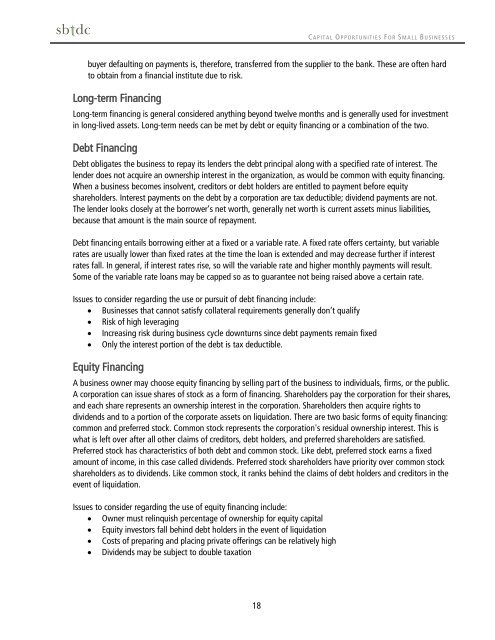Capital Opportunities for Small Businesses - sbtdc
Capital Opportunities for Small Businesses - sbtdc
Capital Opportunities for Small Businesses - sbtdc
You also want an ePaper? Increase the reach of your titles
YUMPU automatically turns print PDFs into web optimized ePapers that Google loves.
C A P I T A L O P P O R T U N I T I E S F O R SMA L L B U S I N E S S E S<br />
buyer defaulting on payments is, there<strong>for</strong>e, transferred from the supplier to the bank. These are often hard<br />
to obtain from a financial institute due to risk.<br />
Long-term Financing<br />
Long-term financing is general considered anything beyond twelve months and is generally used <strong>for</strong> investment<br />
in long-lived assets. Long-term needs can be met by debt or equity financing or a combination of the two.<br />
Debt Financing<br />
Debt obligates the business to repay its lenders the debt principal along with a specified rate of interest. The<br />
lender does not acquire an ownership interest in the organization, as would be common with equity financing.<br />
When a business becomes insolvent, creditors or debt holders are entitled to payment be<strong>for</strong>e equity<br />
shareholders. Interest payments on the debt by a corporation are tax deductible; dividend payments are not.<br />
The lender looks closely at the borrower’s net worth, generally net worth is current assets minus liabilities,<br />
because that amount is the main source of repayment.<br />
Debt financing entails borrowing either at a fixed or a variable rate. A fixed rate offers certainty, but variable<br />
rates are usually lower than fixed rates at the time the loan is extended and may decrease further if interest<br />
rates fall. In general, if interest rates rise, so will the variable rate and higher monthly payments will result.<br />
Some of the variable rate loans may be capped so as to guarantee not being raised above a certain rate.<br />
Issues to consider regarding the use or pursuit of debt financing include:<br />
<strong>Businesses</strong> that cannot satisfy collateral requirements generally don’t qualify<br />
Risk of high leveraging<br />
Increasing risk during business cycle downturns since debt payments remain fixed<br />
Only the interest portion of the debt is tax deductible.<br />
Equity Financing<br />
A business owner may choose equity financing by selling part of the business to individuals, firms, or the public.<br />
A corporation can issue shares of stock as a <strong>for</strong>m of financing. Shareholders pay the corporation <strong>for</strong> their shares,<br />
and each share represents an ownership interest in the corporation. Shareholders then acquire rights to<br />
dividends and to a portion of the corporate assets on liquidation. There are two basic <strong>for</strong>ms of equity financing:<br />
common and preferred stock. Common stock represents the corporation's residual ownership interest. This is<br />
what is left over after all other claims of creditors, debt holders, and preferred shareholders are satisfied.<br />
Preferred stock has characteristics of both debt and common stock. Like debt, preferred stock earns a fixed<br />
amount of income, in this case called dividends. Preferred stock shareholders have priority over common stock<br />
shareholders as to dividends. Like common stock, it ranks behind the claims of debt holders and creditors in the<br />
event of liquidation.<br />
Issues to consider regarding the use of equity financing include:<br />
Owner must relinquish percentage of ownership <strong>for</strong> equity capital<br />
Equity investors fall behind debt holders in the event of liquidation<br />
Costs of preparing and placing private offerings can be relatively high<br />
Dividends may be subject to double taxation<br />
18









